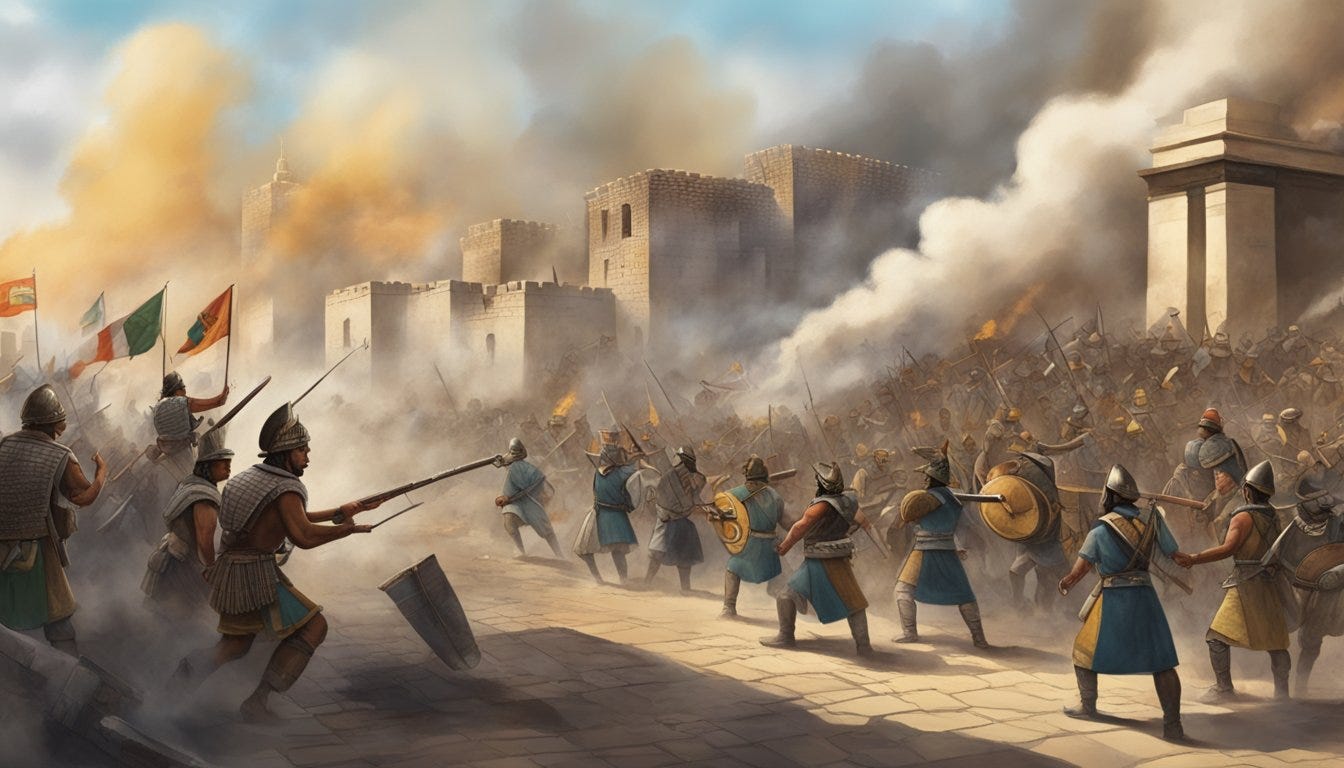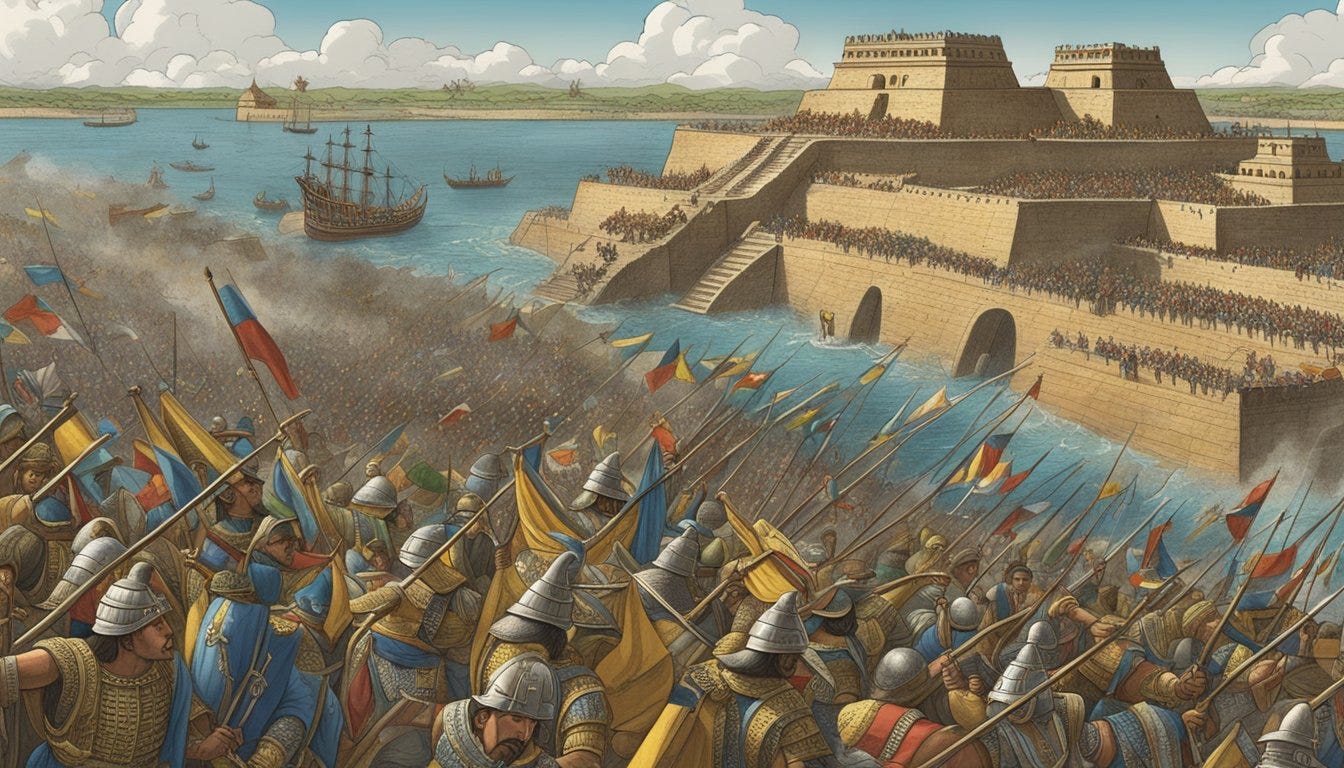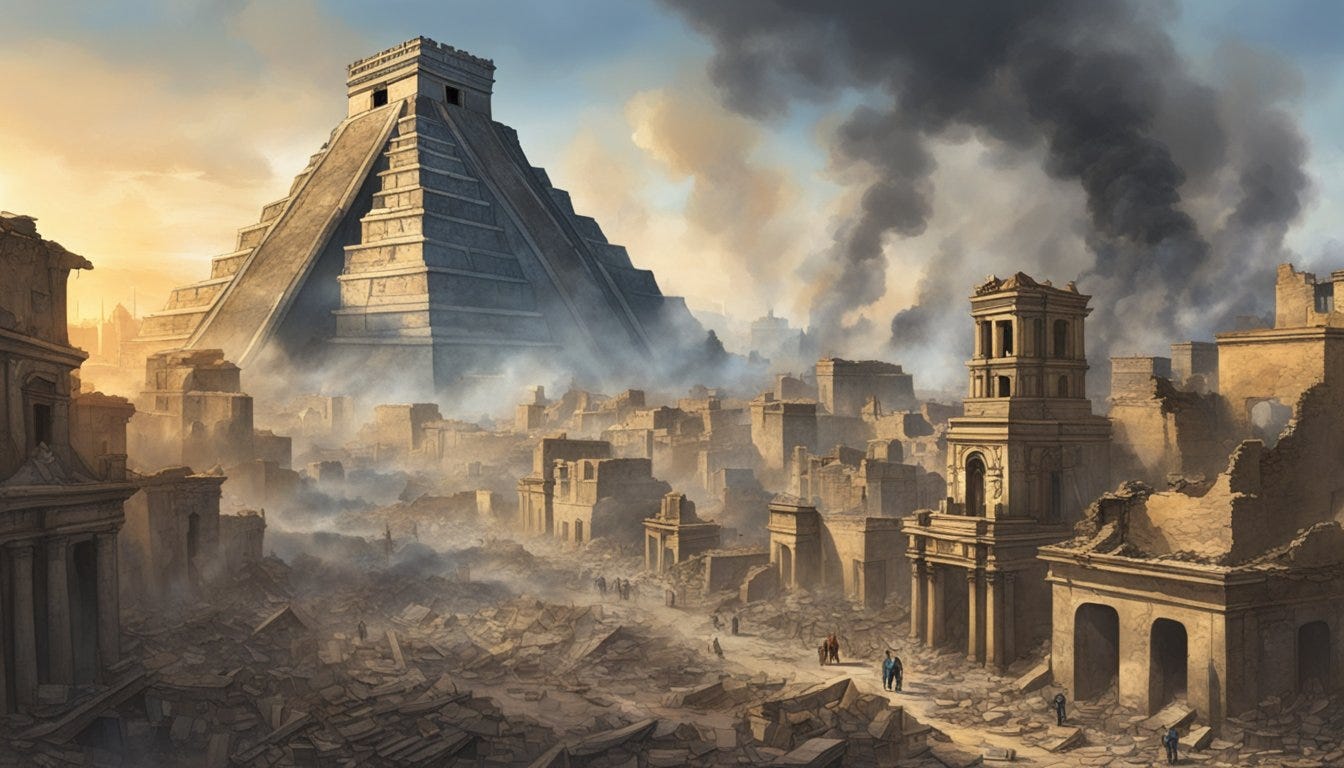The fall of Tenochtitlan marks a significant event in the history of Mexico and the Aztec Empire. The conquest of Tenochtitlan by the Spanish conquistador Hernán Cortés in 1521 resulted in the downfall of the Aztec Empire, which had been one of the most powerful and advanced civilizations in the Americas. The fall of Tenochtitlan also marked the beginning of Spanish rule and European dominance in Mexico.
Background of the Aztec Empire The Aztec Empire, also known as the Mexica Empire, was a Mesoamerican civilization that existed from the 14th to the 16th centuries. The empire was located in the Valley of Mexico and was known for its advanced agriculture, complex social structure, and impressive architecture. The Aztecs also had a powerful military and were able to conquer neighboring territories, expanding their empire.
Key Takeaways
The fall of Tenochtitlan marked the end of the Aztec Empire and the beginning of Spanish rule in Mexico.
The Spanish conquistador Hernán Cortés played a significant role in the conquest of Tenochtitlan.
The fall of Tenochtitlan was also influenced by alliances and the role of disease in the siege.
Background of the Aztec Empire
The Aztec Empire, also known as the Mexica Empire, was a powerful Mesoamerican civilization that dominated central Mexico from the 14th to the 16th centuries. The Aztecs were originally a group of nomadic tribes that migrated into the Valley of Mexico in the early 13th century. They settled in the area around Lake Texcoco and established their capital, Tenochtitlan, in 1325.
The Aztecs were skilled warriors and quickly became a dominant force in the region. They formed alliances with neighboring city-states and engaged in frequent warfare to expand their territory. One of their most notable conquests was the city of Azcapotzalco, which had previously ruled over the region.
The Aztecs were also known for their complex religion, which included a pantheon of gods and goddesses, elaborate rituals, and human sacrifice. They believed that human sacrifice was necessary to appease the gods and maintain the balance of the universe.
Despite their military and religious prowess, the Aztecs faced numerous challenges throughout their history. They were often at odds with neighboring civilizations, such as the Tarascans to the west. In addition, the Aztecs faced internal strife and rebellions, particularly in the latter years of their empire.
Overall, the Aztec civilization was a complex and powerful force in Mesoamerica, with a rich cultural heritage and a legacy that continues to influence Mexican culture today.
Tenochtitlan: The Aztec Capital
Tenochtitlan was the capital city of the Aztec Empire, located on an island in the middle of Lake Texcoco in the Valley of Mexico. The city was founded in 1325 and became the center of the Aztec civilization, with a population estimated to be between 200,000 and 300,000 people at its peak.
The city was built on a series of artificial islands connected by a network of canals and causeways. The heart of the city was the Great Temple, a massive complex dedicated to the Aztec gods. It was one of the largest and most important religious structures in the world at the time.
Tenochtitlan was also a major center of trade, with merchants coming from all over Mesoamerica to buy and sell goods in its markets. The city was renowned for its wealth and beauty, with grand palaces, temples, and gardens.
Despite its grandeur, however, Tenochtitlan was not invincible. In 1521, the city was besieged by the Spanish conquistador Hernán Cortés and his army. The Aztecs fought fiercely to defend their city but were ultimately defeated. The Great Temple was destroyed, along with much of the city, and the Aztec Empire came to an end.
Today, the site of Tenochtitlan is occupied by Mexico City, the capital of Mexico. Despite the destruction wrought by the Spanish, the legacy of the Aztecs lives on in the city's culture and history.
Hernán Cortés and the Spanish Conquest
Hernán Cortés was a Spanish conquistador who led the conquest of Mexico in the early 16th century. He arrived in Mexico in 1519 with a small army of conquistadors and quickly established alliances with some of the local indigenous groups who were unhappy with the rule of the Aztec Empire.
Cortés and his men made their way to the Aztec capital of Tenochtitlan, where they were welcomed by the Aztec emperor, Moctezuma II. However, tensions soon arose between the Spanish and the Aztecs, and in 1520, the Aztecs revolted against the Spanish presence in their city. This event is known as the "Noche Triste" or "Sad Night," during which many Spanish soldiers were killed and their leader, Pedro de Alvarado, was forced to flee the city.
Cortés regrouped his forces and returned to Tenochtitlan the following year, laying siege to the city and eventually capturing it in 1521. The fall of Tenochtitlan marked the end of the Aztec Empire and the beginning of Spanish rule in Mexico.
The conquest of Mexico by Cortés and his conquistadors was a significant event in the history of the Americas. It paved the way for the Spanish colonization of the region, which lasted for several centuries and had a profound impact on the indigenous peoples and cultures of the area.
Alliances and Indigenous Allies
The fall of Tenochtitlan was not the result of a single battle but rather a series of events that occurred over several years. One of the key factors that contributed to the fall of the Aztec Empire was the alliances and indigenous allies that the Spanish were able to secure.
One of the most significant of these alliances was with the Tlaxcalans, a powerful indigenous group that had long been at war with the Aztecs. The Tlaxcalans were initially wary of the Spanish, but they eventually agreed to form an alliance with them in 1519. This alliance proved to be crucial in the Spanish conquest of Tenochtitlan, as the Tlaxcalans provided the Spanish with a powerful ally and a source of troops.
The Tlaxcalans were not the only indigenous group to ally themselves with the Spanish. Other groups, such as the Totonacs and the Huexotzincas, also formed alliances with the Spanish. These alliances were often motivated by a desire to gain an advantage over their enemies or to protect themselves from Aztec aggression.
The Spanish were able to secure these alliances through a combination of diplomacy and military force. They often promised their indigenous allies protection and assistance in their own conflicts, and they also provided them with weapons and other resources.
Despite the importance of these alliances, they were not without their challenges. The Spanish often had to navigate complex political and cultural differences in order to maintain their alliances, and they sometimes faced resistance from their indigenous allies.
Despite these challenges, the alliances and indigenous allies that the Spanish were able to secure played a crucial role in the fall of Tenochtitlan. Without the support of these groups, it is unlikely that the Spanish would have been able to achieve such a decisive victory over the Aztecs.
The Siege of Tenochtitlan
The Siege of Tenochtitlan was a crucial event in the fall of the Aztec Empire. It began on May 26, 1521, and lasted for three months. The siege was led by Spanish conquistador Hernán Cortés and his army of around 80,000 indigenous allies.
Cortés and his men had been in the region for two years, and they had already made alliances with many of the surrounding tribes. They used this to their advantage, as they were able to cut off the city's supply lines and starve the inhabitants.
The Aztec warriors fought bravely, but they were no match for the Spanish guns and cannons. The Spanish also had horses, which the Aztecs had never seen before and were terrified of.
The turning point of the siege was the "Noche Triste," or "Sad Night." On June 30, 1521, the Aztecs launched a surprise attack on the Spanish, forcing them to flee the city. Many Spanish soldiers and their allies were killed, and their retreat became chaotic.
However, the Spanish regrouped and returned to Tenochtitlan two months later. They laid siege to the city once again, and this time, they were successful. On August 13, 1521, the Aztec emperor, Cuauhtémoc, surrendered, and the city fell to the Spanish.
The fall of Tenochtitlan marked the end of the Aztec Empire and the beginning of Spanish colonization in Mexico. The siege was a brutal and devastating event, but it paved the way for the creation of modern-day Mexico.
The Role of Disease in the Fall of Tenochtitlan
Smallpox played a significant role in the fall of Tenochtitlan, the capital of the Aztec Empire. The disease was introduced to the city by Spanish conquistadors, who were immune due to previous exposure. The Aztecs had no immunity to the disease, and it spread rapidly, killing thousands.
The smallpox epidemic weakened the Aztec army, which was already struggling to defend the city against the Spanish. The disease also caused social and economic chaos, as people were too sick to work or trade. This weakened the Aztec economy and made it difficult for the city to sustain itself.
The Aztecs attempted to quarantine the sick, but this was not effective in stopping the spread of the disease. The Spanish also used smallpox as a biological weapon, intentionally infecting captured Aztecs and sending them back to their communities.
The impact of smallpox on the fall of Tenochtitlan cannot be overstated. It weakened the Aztecs both militarily and economically, making it easier for the Spanish to conquer the city. The disease also caused significant social and cultural upheaval as the Aztecs struggled to cope with the loss of so many people.
Overall, the role of disease in the fall of Tenochtitlan was a significant factor in the conquest of the Aztec Empire by the Spanish.
Aftermath and Impact
The fall of Tenochtitlan marked the end of the Aztec Empire and the beginning of Spanish rule in the region. The aftermath of the conquest was marked by significant changes in the political, social, and economic landscape of the area.
One of the most significant impacts of the conquest was the establishment of New Spain, a vast territory that encompassed much of present-day Mexico, Central America, and parts of the United States. The Spanish colonization of the region brought with it a new system of government, religion, and culture that would shape the region for centuries to come.
Under Spanish control, the indigenous population was forced to convert to Christianity and adopt Spanish customs and traditions. The Spanish also imposed a new economic system that favored the interests of the colonizers over those of the native population. This system of exploitation and oppression would continue until Mexico gained its independence from Spain in 1821.
The fall of Tenochtitlan also had a profound impact on the indigenous peoples of the region. The conquest led to the destruction of their way of life and the loss of their cultural heritage. Many indigenous communities were forced to abandon their traditional practices and adopt Spanish ways of life in order to survive.
Despite the devastating impact of the conquest, it also brought about significant changes and advancements in the region. The Spanish introduced new technologies, such as horses and guns, which revolutionized warfare and transportation. The introduction of new crops, such as wheat and sugarcane, also had a significant impact on the region's economy.
Overall, the fall of Tenochtitlan marked a significant turning point in the history of the region. It led to the establishment of Spanish rule, the creation of New Spain, and the eventual emergence of Mexico as an independent nation. While the conquest had a profound impact on the region and its people, it also brought about significant changes and advancements that continue to shape the region to this day.
Indigenous accounts and historiography
Indigenous accounts of the Fall of Tenochtitlan provide a unique perspective on the events that unfolded in 1521. These accounts, written in the Nahuatl language, offer valuable insights into the experiences and perspectives of the indigenous communities that were affected by the conquest of the Aztec empire.
One of the most important sources of indigenous accounts is the Florentine Codex, a 16th-century manuscript written by the Franciscan friar Bernardino de Sahagún with the help of Nahuatl-speaking informants. The codex contains detailed descriptions of Aztec culture, religion, and history, as well as accounts of the conquest and its aftermath.
Historians have long debated the reliability of indigenous accounts, particularly given the challenges of translating from Nahuatl to Spanish and then to English. However, recent scholarship has emphasized the importance of engaging with these accounts on their own terms rather than dismissing them as mere myths or propaganda.
Indigenous accounts have also played a crucial role in shaping contemporary commemoration of the Fall of Tenochtitlan. In Mexico, for example, the anniversary of the conquest is marked as a day of mourning and reflection rather than celebration. This reflects a growing recognition of the enduring impact of colonialism on indigenous communities and the importance of acknowledging their perspectives and experiences.
Frequently Asked Questions
What happened in the Battle of Tenochtitlan?
The Battle of Tenochtitlan was a military conflict between the Aztecs and the Spanish conquistadors led by Hernán Cortés. The battle took place in 1521, and it was one of the most significant battles in the history of the Americas. The Aztecs fought fiercely, but they were eventually defeated by the Spanish.
How long was the battle of Tenochtitlan?
The Battle of Tenochtitlan lasted for three months, from May to August 1521. The battle was a long and grueling conflict that saw both sides suffer heavy losses.
What led to the downfall of Tenochtitlan?
The downfall of Tenochtitlan was caused by a combination of factors. The arrival of the Spanish in the Americas brought diseases that the Aztecs had no immunity to, leading to a devastating epidemic that weakened the Aztec population. Additionally, the Spanish were able to form alliances with other indigenous groups who were hostile towards the Aztecs.
When did Tenochtitlan fall?
Tenochtitlan fell on August 13, 1521, after a long and grueling battle that saw the Spanish conquistadors emerge victorious.
What happened to the Aztecs after the fall of Tenochtitlan?
After the fall of Tenochtitlan, the Aztecs were forced to submit to Spanish rule. Many were enslaved, and their culture and traditions were suppressed. The Aztec civilization, once one of the most advanced in the Americas, was decimated.
Who was involved in the fall of Tenochtitlan?
The fall of Tenochtitlan involved the Spanish conquistadors led by Hernán Cortés and the Aztecs led by their emperor, Moctezuma II. The Spanish were aided by other indigenous groups who were hostile towards the Aztecs.









